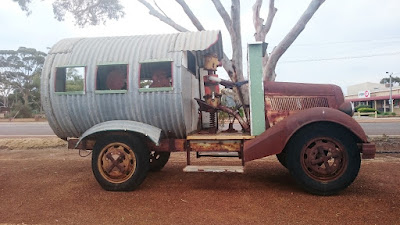After a lovely weekend with Frank and Sue Egan in
Rockingham, south of Perth, we reluctantly left the coastal areas for the
inland. Frank and Sue had shown us the appealing seaside areas of Rockingham
and Mandurah. Rockingham in particular has been beautifully landscaped and
includes many lakes, both natural and artificial. Some, unfortunately, are
surrounded by bush infested with tiger snakes. We also saw the Thrombolites at
Lake Clifton (freshwater versions of the famed stromatolites, and just as
exciting) and had a delicious lunch at Cape Bouvard Winery. We also checked out
their new home in a lifestyle village at Pinjarra. It was great to catch up
with them after such a long time. We wished we had more time to explore the southern
parts of WA, but we have left enough places to see on another trip.
 |
| Rockingham and Mandurah from Point Peron |
 |
| Thrombolites at Lake Clifton |
Our destination was Wave Rock, located at Hyden, about 400km
east of Perth. Contrary to my first imaginings it is nowhere near the ocean or
any other type of wave. We had received mixed reports about it varying from
"Why bother, it's just a rock" to "There are lots of things to
see and do there". So it became a matter of go and see and make up your
own mind.
Hyden is a small town of about 400 people in the middle of a
major wheat growing area. It is heavily reliant on the tourist trade to bring
money into the town and keep people employed. As it doesn't have a major
supermarket it still has a butcher, which many much larger towns don't. It also
has a very chatty librarian, who I suspect, doesn't have many people dropping
by. The town has a historical display made of outdoor metal sculptures, and its
garage gives caravan park patrons 4 cents a litre off fuel.
On the way we passed through Corrigan which has a dog cemetery, some graves shown below.
 |
| Above and below - sculptures in Hyden |
 |
| Beautiful countryside at Hyden |
Wave Rock itself is part of Hyden Rock which has several
minor features such as the formation known as Hippo Yawn, the Breakers which are small rocks, and the
Hyden water storage dam. According to the Guru,
the wave shape has been formed because the lower rock was wetter and
eroded more quickly, creating an overhang at the top. When we first saw it late
in the afternoon it looked rather dull, but David went for a walk early in the
morning after it rained and it looked much more spectacular.
 |
| Plants growing on top of the rock |
 |
| Looking down from the top. Notice the safety ledge |
 |
| The morning light is much better, especially after rain |
 |
| Hippo Yawn |
 |
| David took this photo of a reflection for me |
Much more interesting to me were the Humps, a rock formation
about 18km away. Although it was quite steep in places I was more concerned
about coming down a steep slope than climbing up. However it was definitely
worth the climb. We probably saw it at its best as the rock crevices were full
of water and the plant life was quite different with a lot of mosses and
lichens (yes, I know they aren't really plants) and some tiny carnivorous
plants, among many other species. The Guru felt the need to give me a lesson on plant sucession, but my camera diverted my attention
elsewhere.
The Humps also contains Mulka's Cave, an Aboriginal rock art
site with hundreds of hand stencils, but we could only see a handful as the
floor of the cave was covered with large rocks.
 |
| Approaching The Humps |
 |
| Canola crop and interesting weather |
 |
| The entrance to Mulka's Cave |
 |
| Hand stencils in the cave |
 |
| Walking up the Humps, beautiful plant life |
 |
| Tiny carnivorous plants |
 |
| Another wave rock in the making |
 |
| Towards the top. At the top it was too windy to hold a camera, felt like I could be blown off the edge |
There are several other places to visit near Wave Rock
including the Lace Place, Toy Soldiers display and a wildlife park to name a
few. I found the Lace Place interesting,
with displays from the 1600s to the present, but David stayed at camp to
find someone to chat to, and to gather some wood for the firepits generously
placed around the caravan park. We had an excellent fire, the first for ages,
mostly fuelled by mallee roots.
Our verdict was that Wave Rock and the surrounding area had
enough of interest to see, and was definitely worth the visit.



























Great pics.
ReplyDelete